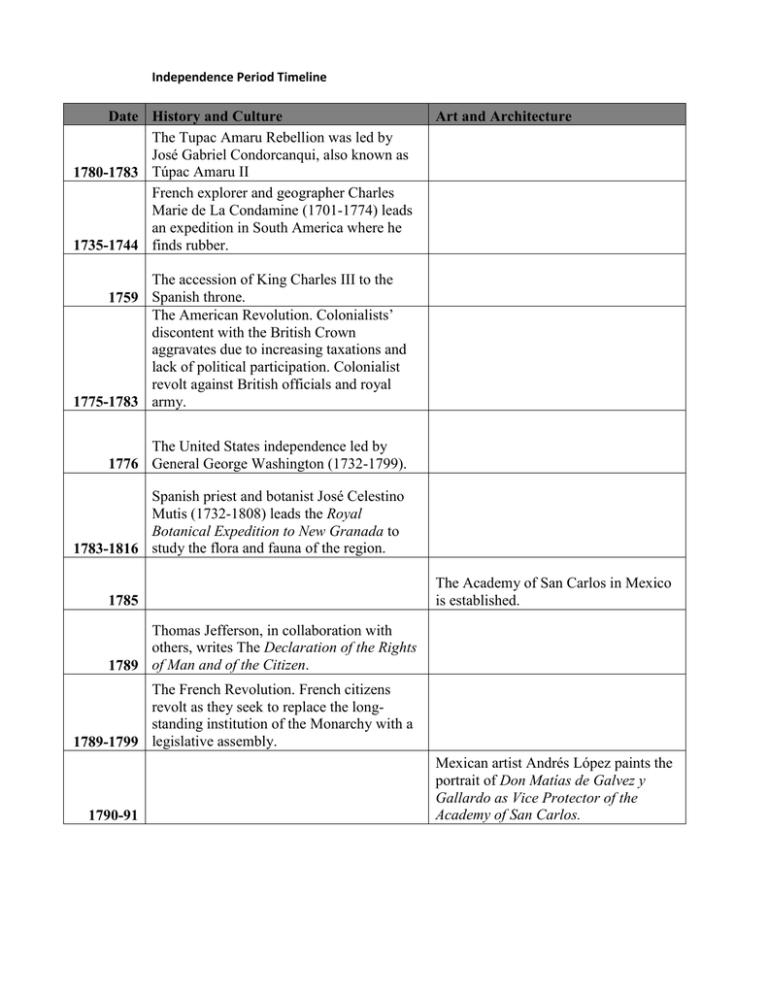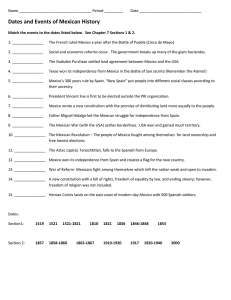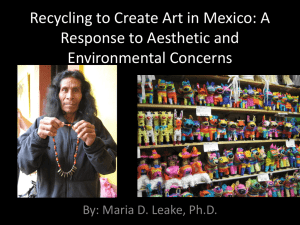Independence Timeline
advertisement

Independence Period Timeline Date History and Culture The Tupac Amaru Rebellion was led by José Gabriel Condorcanqui, also known as 1780-1783 Túpac Amaru II French explorer and geographer Charles Marie de La Condamine (1701-1774) leads an expedition in South America where he 1735-1744 finds rubber. Art and Architecture The accession of King Charles III to the 1759 Spanish throne. The American Revolution. Colonialists’ discontent with the British Crown aggravates due to increasing taxations and lack of political participation. Colonialist revolt against British officials and royal 1775-1783 army. The United States independence led by 1776 General George Washington (1732-1799). Spanish priest and botanist José Celestino Mutis (1732-1808) leads the Royal Botanical Expedition to New Granada to 1783-1816 study the flora and fauna of the region. 1785 The Academy of San Carlos in Mexico is established. Thomas Jefferson, in collaboration with others, writes The Declaration of the Rights 1789 of Man and of the Citizen. The French Revolution. French citizens revolt as they seek to replace the longstanding institution of the Monarchy with a 1789-1799 legislative assembly. 1790-91 Mexican artist Andrés López paints the portrait of Don Matías de Galvez y Gallardo as Vice Protector of the Academy of San Carlos. Slave revolt on the French island of SaintDominique (Haiti) that eventually leads to 1791-1804 its independence. 1793 All guilds are abolished in Quito. The Colombian creole and military general Antonio Nariño (1765-1823) translates into Spanish the Declaration of the Rights of 1793 Man and of the Citizen. Prussian explorer Alexander von Humboldt (1769-1859) and French botanist Aimé Bonpland (1773-1858) survey the territory of Latin America collecting and classifying 1799-1804 thousands of plants unknown in Europe. Napoleonic Wars. After declaring himself Emperor, Napoleon led a series of imperialist raids against various European powers. The Wars ended with Napoleon’s 1803-1815 failed invasion of Russia in 1815. Haiti gains its independence from France, under the leadership of Toussaint 1804 L’Ouverture (1743-1803). Napoleon self-proclaimed himself emperor of France. Portuguese royal family moves to Brazil to 1807-1821 escape Napoleon. The French invade Spain and Napoleon’s brother Joseph Bonaparte (1768-1844) 1808 seizes the Spanish throne. First South American independence 1809 movement begins in Chuquisaca (Bolivia). (September 16) Grito de Dolores Hidalgo. The priest Miguel Hidalgo issues a cry for 1810 independence near Guanajuato - Mexico. In Cuba, the Aponte Conspiracy is instigated by the Afro-Cuban activist José Antonio 1812 Aponte (d. 1812). Friedrich George Weitsch paints Alexander von Humboldt and Aimé Bonpland at the Foot of the Chimborazo. José Maria Morelos convokes the first Mexican Congress, which formally declares Mexican Independence. Slavery is also 1813 abolished. Alexander von Humboldt and Aimé Bonpland’s findings were published in Views of the Mountain Ranges and Monuments of the Indigenous Peoples of America. A series of civil wars facilitated the temporary re-conquest of the United 1814-1816 Provinces of New Granada by Spain. Mexican Revolutionary leader José Maria Morelos (1765-1815) is defeated and 1815 executed. Argentine General and Independence leader José de San Martín (1778-1850) liberates Argentina (1816), Chile (1818) and Peru 1816-1821 (1921). 1817 Construction of Mexico City’s Metropolitan Cathedral ended with Manuel Tolsa’s Neoclassical contribution to the façade. 1818 Chile gains its independence from Spain. Battle of Boyacá – Venezuelan military and political leader Simon Bolívar initiates his fight for independence with a series of military victories and the expulsion of the viceroy of Nueva Granada, Juan José 1819 Francisco de Sámano (1753-1821). ca. 1820 The Republic of Gran Colombia (formerly the Viceroyalty of New Granada) was established at the Congress of Cúcuta. During the congress, Simón Bolívar was 1821 elected president. Colombian portraitist, Pedro José Figueroa (1780-1838) paints Simón Bolívar: The Liberator of Colombia. Independence of Mexico and Guatemala. Don Pedro I – King of Portugal proclaims Brazilian Independence and crowns himself 1822 Emperor. A rebellion led by Antonio López de Santa Anna (1794-1876) forces the abdication of independence leader and dictator Agustín de 1823 Iturbide establishing the Mexican Republic. Peruvian portraitist Gil de Castro painted the Peruvian martyr of independence, José Olaya (1782-1823). With the last patriot victories against the Spaniards, Simón Bolívar and Antonio José Founding of the Academia Imperial de Bellas Artes in Brazil. 1824 de Sucre liberate Peru. The French chemist Nicéphore Niépce (1765–1833) produces the first photographic negative and, the earliest surviving 1826 photographic image. 1825 Bolivia declares independence. Simón Bolívar proclaims himself dictator following the self-imposed exile of the liberator of the Viceroyalty of La Plata, José 1828 Francisco de San Martín. Juan Manuel Blanes documents the Uruguayan war of independence from Brazil in his historical painting titled Oath of the Thirty-Three Orientals. Democracy is established in Mexico with the election of the first president, Guadalupe 1829 Victoria (1786–1843). The Republic of Gran Colombia dissolves due to internal political divisions between conservatives and the liberals. In the following years the countries of Colombia, Venezuela, Ecuador and Panama, are 1830 established. 1831 Bolivia abolishes slavery. Mexican artist Antonio Serrano paints Portrait of Miguel Hidalgo. The United Kingdom abolishes slavery 1833 within the British Empire. 1834 French painter Jean-Baptiste Debret (1768-1848) published the Picturesque and Historical Voyage of Brazil. The State of Texas declares its independence from Mexico and begins a 1836 war against the central government. German artist Carl Nebel (1805-1855) documented the people of the different regions of Mexico in his publication Most Interesting Part of Mexico. United Provinces of Central America breaks into five republics: Guatemala, El Salvador, 1838 Honduras, Nicaragua, and Costa Rica. 1841 Mexican-American War. The expansionist ideals (Manifest Destiny) of U.S President James K. Polk leads U.S armies to invade Mexican territory after battles fought at Rio 1846-1848 Grande. British draftsman Frederick Catherwood (1799–1854) and American writer John Lloyd Stephens (1805–1852) publish the illustrated Incidents of Travel in Central America, Chiapas, and Yucatán. Their work spurs interest in Maya ruins. Spanish artist Edward Walhouse Mark (1817-1895) paints the watercolor Plaza Mayor, Bogotá. The Caste War – The Maya rebel against 1847-1848 plantation owners in Yucatán, Mexico. Treaty of Guadalupe Hidalgo cedes northern half of Mexico to the U.S after the 1848 - Mexican-American Wars. ca. 1850 Agustín Codazzi leads the Comisión Corográfica (Corographic Commission) - a specialized expedition to survey the 1850-1859 different territories of Colombia. 1851 Costa Rica abolishes its army. Colombian artist and Chronicler José María Espinosa (1796-1883), who served as a correspondent in General Nariño’s Campaign of the South, paints The Battle of Palo River. Mexican artist Juan Cordero (18221884) paints Columbus Before the Catholic Monarchs. The Spanish-born sculptor Manuel Vilar (1812-1860) sculpts The Tlaxcalan General Tlahuicole Doing Battle on the Gladiator’s Stone of Sacrifice. Peru, Argentina and Venezuela abolish 1854 slavery. The Exposition Universelle is held in Paris with the aim of displaying the social, industrial, and cultural progress of France 1855 under Napoleon III. A new and liberal Constitution is approved in Mexico opposing the interests of the 1857 Church and Mexican conservatives. Peruvian painter and politician José Francisco Domingo Laso (1823-1869) paints The Inhabitant of the Cordillera of Peru. Civil War breaks out in Mexico between the liberals and conservatives, and Benito 1858-1861 Juárez (1806–1872) is elected president. Francisco Oller moves to France where he studies under Thomas Couture and Gustave 1858-1865 Courbet. Charles Darwin published his book On the Origin of the Species inspired by his trip 1859 through the Pacific coast of South America. American Landscape painter Frederic Edwin Church’s paints Heart of Andes. The French Army, supported by Mexican Conservatives, invades Mexico. The War of the French Intervention (Maximilian Affair) begins when Napoleon invades Mexico to establish access to Latin American markets and exploit natural resources to finance his 1862 empire. 1862–63 Cuba abolishes slave trade. 1863 Photographer Désiré Charnay's (1828– 1915) publishes his photo album Cités et Ruines Américaines, based on his expedition in 1857. The Salon des Refusés is established in Paris to exhibit works rejected by the jury of the French Salon. The French Army and Mexican Conservatives establish the Second Mexican Empire, crowning the Austrian archduke Maximilian von Hapsburg emperor of 1864 Mexico. The U.S. abolishes slavery with the Thirteenth Amendment to the United States 1865 Constitution. The Mexican liberal army executes Emperor Maximilian I. Benito Juárez reestablishes 1867 the Republic. Ten Years’ War - The fight for Cuban independence began with the cry of Yara, and an uprising led by Cuban-born planters and other wealthy natives including sugar mill owner Carlos Manuel de Céspedes 1868-1878 (1819-1874). The Académie Julian in Paris is founded by Rodolphe Julian. The Académie was a private studio school where independent training in the arts was offered. 1869 Mexican Costumbrista artist José María Obregón (1832-1902) paints El Descubrimiento del Pulque. Bananas are introduced as a cash crop to Costa Rica, and soon the fruit expands 1870s across Central and South America. Death of Benito Juárez. Sebastián Lerdo de Tejada (1823-1889) becomes President of 1872 Mexico. Porfirio Díaz overthrows Lerdo de Tejada and becomes President in Mexico. He will reelect himself seven times, and his dictatorship, the "Porfiriato," lasts thirty1876 four years (1876-1911). 1877 Mexican costumbrista painter Félix Parra (1845-1919) paints Episodes of the Conquest: Massacre of Cholula. War of the Pacific – Armed despite between 1879-84 Chile, Peru and Bolivia over territory. 1880 1885 Colombian portraitist Epifanio Garay (1849-1903) immortalizes the revolutionary martyr, Policarpa Salavarrieta (Colombian, 1795-1817) in a portrait of the heroine. Mexican landscape painter José María Velasco (1840-1912) creates Atlas Pintoresco e Historico de los Estados Unidos Mexicanos (Picturesque Historical Atlas of the United States of Mexico). 1886 Cuba abolishes slavery for all. 1888 Abolition of slavery in Brazil. Brazil is proclaimed a republic with the 1889 abdication of Emperor Don Pedro II. Mexican illustrator José Guadalupe Posada (1852–1913) opens his first print shop in Mexico City to illustrate and publish newspapers and broadsheets. The Exposition Universelle is held in Paris. The Eiffel Tower, designed by Gustave Eiffel (1832–1923) is erected for the centennial celebration of the French Revolution. Political activist and literati José Julián Martí Pérez (1853-1895) and Major General Máximo Gómez y Báez (1836-1905) write the Montecristi Manifesto where they laid out the arguments that inspired the Revolutionary Party in Cuba to pursue their 1895 Independence from Spain. The Italian ethnologist Guido Boggiani (1861–1902) explores the indigenous people of the Gran Chaco (parts of Paraguay, 1896-1901 Argentina, Bolivia and Brazil). Spanish-Cuban-American War ends with the signing of the Treaty of Paris, through which Cuba gains its independence and Puerto Rico becomes a territory of the 1898 United States. 1899 Venezuelan academic artist Francisco Arturo Michelena Castillo (1863-1898) paints Miranda in La Carraca. The Brazilian Realist artist José Ferraz de Almeida Júnior (1850-1899) paints The Guitar Player. The Foraker Act establishes civil government in Puerto Rico and allows for free trade between the island and the United 1900 States. The Republic of Panama declares its independence from Colombia with the 1903 backing of the United States and France. 1907 1910 Colombian Impressionist artist Andrés de Santa Maria (1860-1945) paints Return from the Market. Exposición Internacional del Centenario in Buenos Aires, Argentina.





